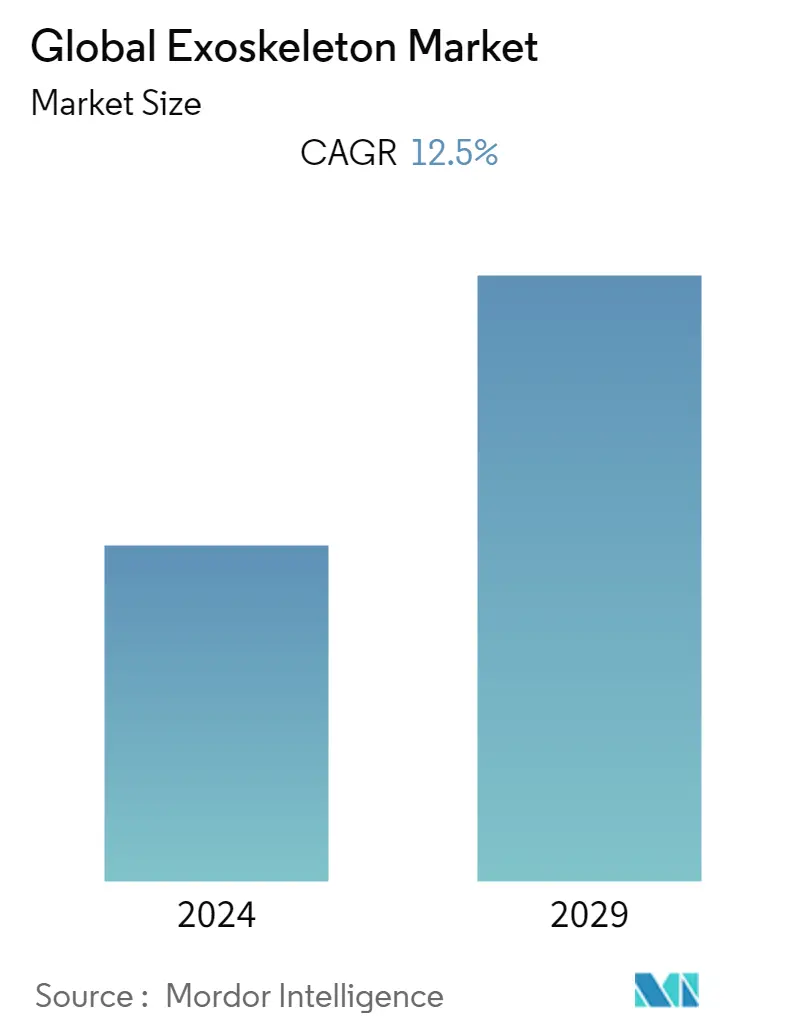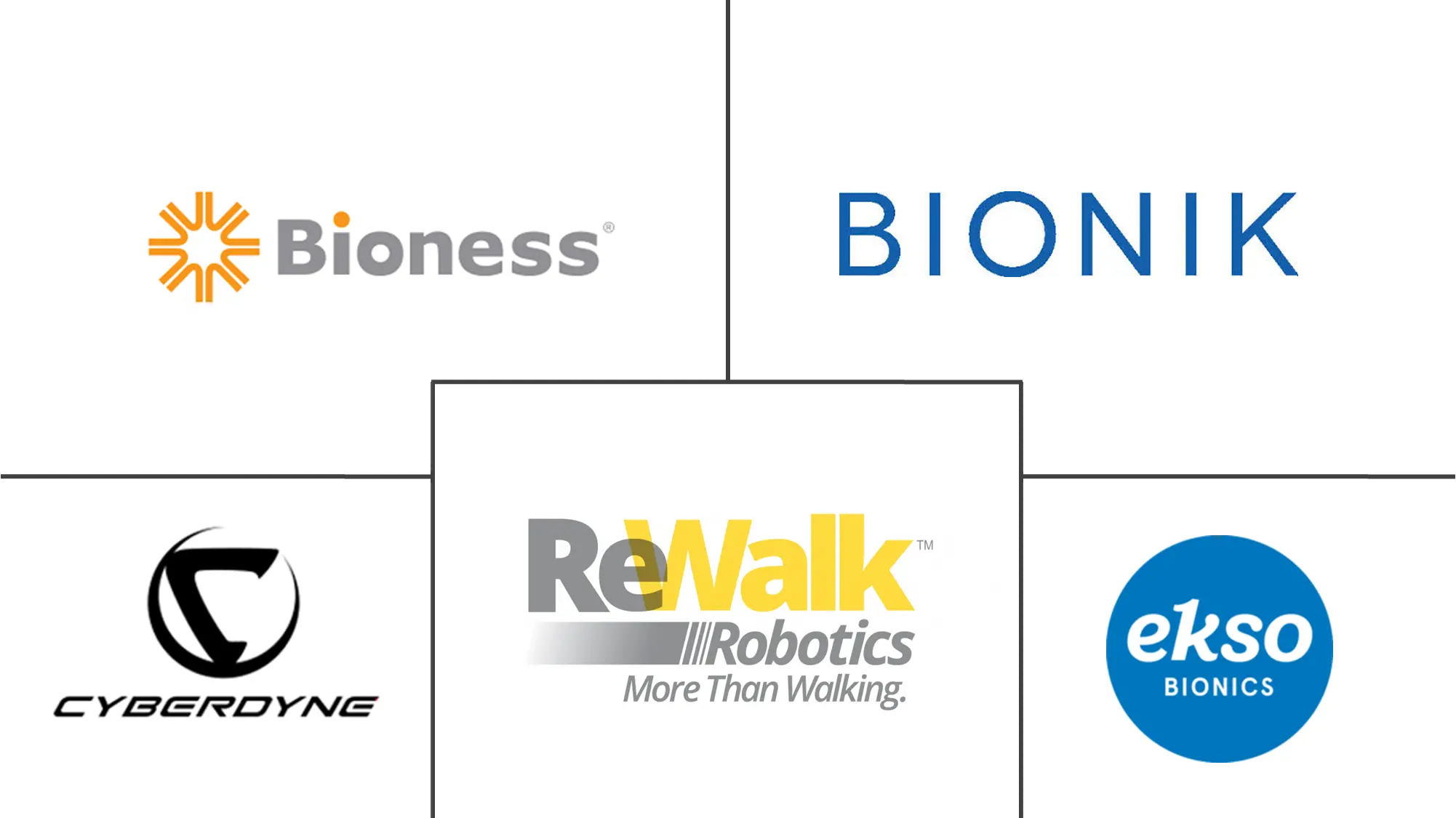Market Size of Global Exoskeleton Industry

| Study Period | 2019 - 2029 |
| Base Year For Estimation | 2023 |
| CAGR | 12.50 % |
| Fastest Growing Market | Asia Pacific |
| Largest Market | North America |
| Market Concentration | Medium |
Major Players
*Disclaimer: Major Players sorted in no particular order |
Need a report that reflects how COVID-19 has impacted this market and its growth?
Exoskeleton Market Analysis
The exoskeleton market was valued at USD 354.22 million in 2021, and it is expected to reach USD 1620.04 million in 2027, registering a CAGR of 12.5% during the forecast period (2022-2027).
The COVID-19 pandemic is an unprecedented health concern, causing a huge setback. The pandemic significantly impacted the exoskeleton market worldwide. The use of exoskeletons is increasing in the management of COVID-19 patients with prolonged disability and problems in movement. For instance, as per a research article published in 2020, titled 'The use of exoskeletons to help with prone positioning in the intensive care unit during COVID-19', the preliminary results confirmed that the use of an exoskeleton for lumbar support is fully justified. The study states that using an exoskeleton to assist medical staff could be helpful and readily feasible, even in the context of the COVID-19 pandemic. As per a research article published in 2021, titled 'Biomechanical effects of using a passive back support exoskeleton during prone-positioning maneuver: A pilot study', during the COVID-19 pandemic, intensive care unit (ICU) staff had to perform prone-positioning (PP) of a large number of intubated patients suffering from acute respiratory distress syndrome (ARDS) many times a day. The study revealed that using the Laevo could help reduce the musculoskeletal load on the lower back during prone positioning maneuvers without causing any significant negative side effects or modifying the practice. The study states that two Laevos were successfully deployed in intensive care units of Centre Hospitalier Régional Universitaire de Nancy (CHRU Nancy), and they were used for six months. Thus, the demand for exoskeletons was significant during the pandemic. With the removal of lockdowns and the development of vaccines, the demand for exoskeletons as a part of rehabilitation is expected to increase. However, as per Ekso Bionics' 2020 annual report, the demand for exoskeleton products dramatically decreased by 38.0% during the onset of the pandemic, leading to the booking of 61 units in 2020 compared to 98 units in 2019.
The major factors propelling the market's growth are the rising prevalence of stroke, increasing adoption of the exoskeleton, and the growing geriatric population at a global level. With the increasing number of disabled and aged people, there has been an increase in the demand for robotic rehabilitation worldwide. In recent years, the demand for physical therapy services has grown, partly because of the aging population. The role of technology in healthcare has become evident with the enhanced rate of survival from medical disorders, such as stroke. Therefore, robotic rehabilitation and assistive technologies promise to ease the stress on the physiotherapy staff and control expenses while refining patients' quality of life.
There has been a growing demand for these robotic rehabilitation devices that are showing an upward trajectory as the prevalence of disability worldwide is increasing. For example, the United Nations estimates that the global geriatric population will reach 2.1 billion by 2050. The rates of disability are increasing due to the aging population and an increase in chronic health conditions. Therefore, the applications of robotic rehabilitation are growing fast with the market for these systems. One example is a robot developed at McGill University that helps patients who use wheelchairs to walk. It supports gait training and neuro-rehabilitation. Other researchers and companies are also developing products using robotics and 3D printing to help patients with movement disorders from an impaired spinal cord or due to stroke, Parkinson's disease, and multiple sclerosis. Numerous hospitals started using robotics within their rehabilitation centers. Product launches and innovations through key market players are another reason for the market's growth. For instance, in February 2020, Ekso Bionics announced a collaboration with Kindred Healthcare to pilot EksoNR in long-term acute care hospitals. Similarly, in January 2020, Bionik laboratories announced the regulatory approval and the first sale of its InMotion arm robotic technology by its exclusive distributor in South Korea. Hence, all these factors are expected to drive the overall market.

